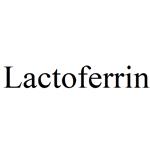Lactoferrin is blood-brain barrier (BBB) traversable and has therapeutic potential to regulate inflammation, immunity and apoptosis in Parkinsonμs disease. It promotes the expression of brain-derived neurotrophic factor (BDNF) via various signaling pathways and aids protection in motor dysfunction. Lactoferrin favors osteogenic differentiation and proliferation of human adipose-derived stem cells (hADSCs). It exhibits proteolytic activity on Haemophilus influenzae colonization factors. Lactoferrin is also a nutraceutical and a potential marker in the pathophysiology of inflammatory bowel diseases, leukocytes', 'Lactoferrin is an iron binding protein. It is structurally similar to transferrin, the plasma iron transport protein; but lactoferrin has a much higher affinity for iron (250 fold). It is very abundant in colostrum and small amounts can also be found in tears, saliva, mucous secretions and in the secondary granules of neutrophils. It is made by mucosal epithelium and neutrophils and is released by these cells in response to inflammatory stimuli. Bacterial growth is inhibited by its ability to sequester iron and also permeabilize bacterial cell walls by binding to lipopolysaccharides through its N-terminus. Lactoferrin can inhibit viral infection by binding tightly to the viral envelope protein. This prevents cell-virus fusion by blocking the binding domain. Lactoferrin appears to activate host defense systems in part by stimulating the release of interleukin-8, a neutrophil activator. It may also be involved in antibody and interleukin synthesis, lymphocyte proliferation and complement activation.
